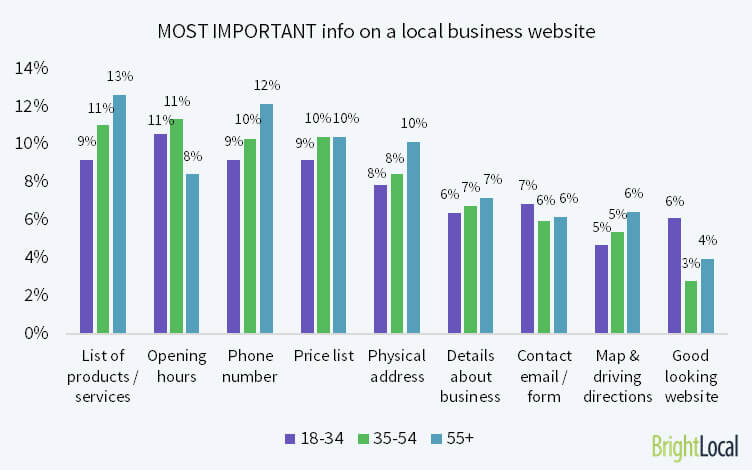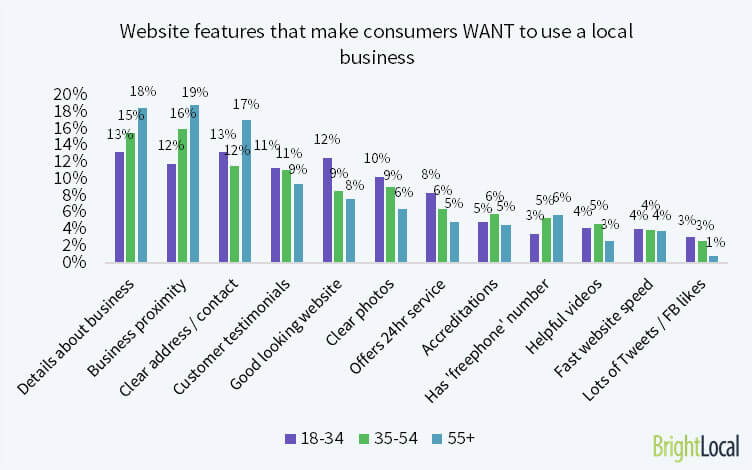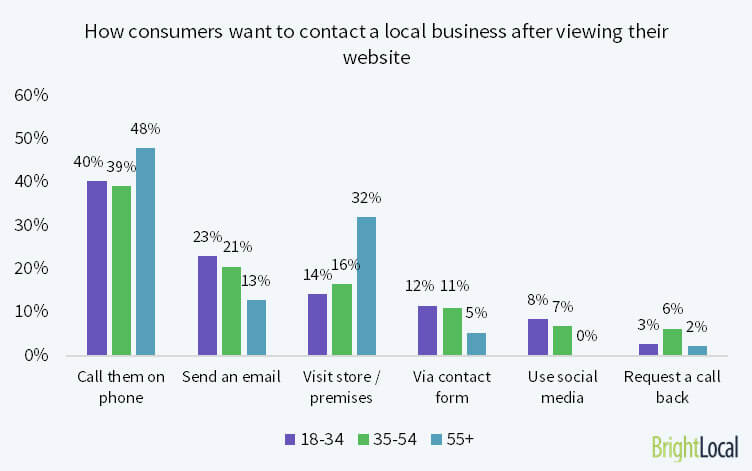What different consumer groups really want from local business websites
Columnist Myles Anderson takes a look at what consumers in different age groups are looking for when it comes to local business websites. Local SEO practitioners, take note!

In February at BrightLocal, we published an annual survey that explored consumer attitudes towards local business websites. The survey looked at what consumers expect, want and don’t want from those websites, as well as how consumers prefer to contact a local business after viewing their website.
The results are vital for SEOs who handle local business clients, because they show which online factors are most likely to influence consumers into using a local business — and which factors are most likely to deter them.
Because so many local businesses target consumers of different ages, we’ve published a follow-up which breaks down the data by age of the consumer. We hope this will help SEOs with local business clients understand how to best target and cater to different ages of consumers with their content and website strategy.
In the original survey, there were 800 respondents from the United States. The age breakdown was as follows:
- Age 18–34: 44 percent
- Age 35–54: 34 percent
- Age 55+: 22 percent
We’ve looked at the following charts by age breakdown:
Consumer attitudes towards local business websites
From the original survey, it was clear that consumers expect a local business to have a professional website, and they are more likely to make contact with the business if they do.
It arose that having a bad or ugly website may not be the worst thing to consumers, either — you often have more to lose by not having one. Let’s look at the age breakdown:
Consumers ages 18–34
Consumers in this bracket are more likely to contact a local business if they have a website, and they believe that a well-presented website gives that business credibility.
Of all the age groups, younger consumers are the most insistent about a business having a website and are the most put off by a “bad or ugly” website. Local businesses targeting young consumers should ensure they have a website that is clear and well-presented.
Consumers ages 35–54
“Mid-life” consumers are just as likely as younger consumers to contact a local business if they have a website, but are less insistent about them having one in the first place.
In fact, this age group is the least likely to give credibility to a smart-looking website or be put off by a “bad or ugly” website. So a website is important, but the look of that website is less so.
Consumers ages 55+
Older consumers are the least likely to contact a local business just because they have a website and more likely to say it “doesn’t make a difference” whether a business has a website or not.
However, if a local business does have a smart website, then they are the most likely to give that business credibility because of it.
Key information on a local business website
Consumers of all ages consider a list of products, opening hours, phone number, price list and address details to be the most important information on a local business website. There are variations when looking at consumers of different ages:
Consumers ages 18–34
To younger consumers, opening hours are the most important individual piece of information. Their time is valuable, and they want to know when they can visit that business.
Whilst this age group also values product lists, they do place less importance on it than other age groups. However, younger consumers place a higher priority on a “good-looking website” than other age groups.
Consumers ages 35–54
To mid-life consumers, opening hours and lists of products are the key info to display. They want to know what services are being offered and when they can buy them.
They are more insistent about key info than younger consumers but less concerned with a “good-looking website.”
Consumers ages 55+
A list of products and a phone number are absolutely key for older consumers, and they are more insistent about these features than other age groups.
A physical address and business details are also key, but opening hours are of lesser importance.
Website factors that make consumers WANT to use a local business
These factors represent the features that are most likely to persuade a consumer to use that business. Details about the business (e.g., company origins, products, services, people), business proximity, clear address and contact details and customer testimonials were considered the most influential factors overall.
Consumers ages 18–34
Younger consumers are most influenced by details about a business and clear address/contact details, albeit to a far lesser extent than older consumers.
Generally, they are influenced by a much broader set of website features, not just three or four. This extends to customer testimonials, a good-looking website and having clear photos.
Consumers ages 35–54
Mid-life consumers are most influenced by business proximity and details about that business. The distance of a business (proximity) matters more to them than younger consumers, whilst address and contact details are less persuasive than they are to older consumers.
Consumers ages 55+
For this age group, it’s a clear top three of influential factors: business proximity, details about a business and clear address/contact details.
These are the main website features that make older consumers want to use a local business. Social proof (Tweets and Facebook likes) is almost irrelevant, whilst online videos prove to have very little influence at all.
Common problems on local business websites
The biggest negatives for a local website proved to be poor quality content, no phone number displayed, no prices displayed and the business not being local enough. Consumers of all ages are deterred by these problems, but to varying amounts:
Consumers ages 18–34
Once again, younger consumers consider a wider range of website features before judging a website. They are more tolerant and consider a lot more factors before dismissing that business.
However, local businesses beware: This age group are the most put off by slow or buggy websites, ugly or outdated websites and websites that are not mobile-friendly. Technical factors are a lot more important to them.
Consumers ages 35–54
Mid-life consumers are more demanding than younger consumers but more relaxed than older ones. Features such as mobile friendliness, map and driving instructions and an updated blog are not as important to these consumers.
Consumers ages 55+
When we consider the biggest obstacles overall, they become more magnified for older consumers than any others. The top four issues — content, phone number, prices, proximity — are key for local businesses to get right. But after that, these consumers are generally more relaxed on other features.
How consumers prefer to contact a local business
From the original survey, we learned that consumers of all ages prefer to contact local businesses on the phone after viewing their website. However, there are some differences to consider beyond that:
Consumers ages 18–34
Younger consumers are the most happy to use social media as a contact method, but they would much rather telephone, email or visit in person. Telephone and email contact are preferred to a store visit.
Consumers ages 35–54
Mid-life consumers also prefer telephone contact and, similar to the younger age group, prefer to email a business rather than visit in person.
Consumers ages 55+
Older consumers are the most keen to contact a business via telephone, and they are overwhelmingly the most in favor of visiting a local business in person. Email contact is less preferred by this age group than any other, whilst contact forms and call-back services are not ideal. Social media contact is non-existent!
You can view the full report, including further analysis of age and gender of consumers, on the BrightLocal blog.
Contributing authors are invited to create content for Search Engine Land and are chosen for their expertise and contribution to the search community. Our contributors work under the oversight of the editorial staff and contributions are checked for quality and relevance to our readers. The opinions they express are their own.
Related stories
New on Search Engine Land




